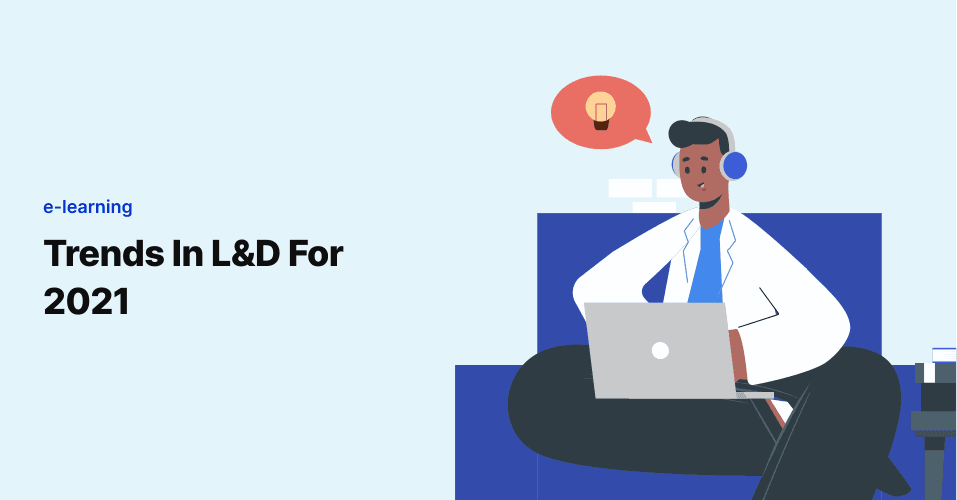
Best Practices for Students Taking E-learning
E-learning is a wonderful way to train all styles of learners. Because it is newer than the traditional live …

While companies have been slowly increasing their rate of virtual training production over the last several years, 2020 propelled this into a necessity. Employees now continue to work remotely, and as a result, we will likely see virtual training become a standard facet of business culture. As many organizations lept head-first into the world of virtual training last year in reaction to the pandemic, they will likely find themselves refining their offerings this year as virtual learning grows in popularity.
If mobile devices are the default method of accessing regular communications, such as email, text messaging, and social media, why shouldn’t training be accessed similarly? In addition, the term “mobile experience” means different things to different people and should be explored accordingly. Does this mean simply making learning available on various mobile devices, or does it mean expanding it to mobile platforms? Classrooms no longer have walls, and neither should learning. Employees are away from the workplace more than ever, and with their work turning mobile, learning should follow suit.
As of 2016, Millennials (those born between 1981 and 1996) are the largest age demographic in today’s workforce. The need for recruiting and retaining Millennials is of the utmost importance. But following right behind them is the introduction of a new age, commonly referred to as “Gen-Z.” These new workers (born between 1997 – present) will bring with them a host of new needs and interests, as we will soon discover.
The Covid-19 pandemic produced an immediate need for learning more rapidly. This learning, which involves reinforcing current skills, learning more advanced skills, and continuing education, takes time to produce. However, time is no longer a luxury that businesses have. Training is needed sooner, using collaborative techniques with the ability to be updated rapidly.
Feedback, both pertaining to job performance and learning new skills, is a necessary part of learning. It reinforces concepts, assists in their retainment, and helps employees stay engaged and feel secure. Annual performance evaluations may have once been the standard, but as more employees are working remotely, the need for real-time feedback is more important than ever.
You may have heard this term before, or even similar terms such as “chunking” or “bite-sized learning”. Microlearning is more than just splitting content from a larger course into smaller pieces. It actually allows for learning in the flow of work. Typically, microlearning is only a few minutes long at most. It can be accessed anywhere, anytime, and is usually tied to a specific objective. You may have even heard it referred to as “just in time” learning, providing knowledge right in the instant it is needed. If you were to ask a Millennial, they would tell you how much they prefer this type of learning over the classroom format. Microlearning is also much more economical since its creation is much less time and resource-intensive. Some examples of microlearning are videos (such as those on YouTube), infographics, simulations, scenario-based learning, podcasts, social media, and job aids – which also serve as performance support, our next trend in the list.
Merging task completion with just-in-time learning is one of the most efficient forms of performance support. Much like having an on-demand trainer available 24/7, performance support is imperative when your organization is going through a software conversion or a complex EHR upgrade. In 2020. 314e launched its new performance support tool, Speki, as a direct response to this growing need. To learn more about Speki, click here: Speki-EHR Help.
Aristotle said, “The more you know, the more you know you don’t know.” Data is the key to understanding where we are and where we need to be as an organization, especially with respect to knowledge and learning. Through the use of data, you can target learning specifically where it is needed. You can help determine your current productivity and areas needing improvement. In addition, data literacy has been equated to the new “computer literacy.” It’s not just for data scientists to understand data any longer. Understanding your data can direct the flow of training needed for your workforce. While more progressive companies have been using data to drive their learning needs, this will soon become the standard for all.
Through the use of social media platforms such as Facebook, Twitter, LinkedIn, YouTube, and various learning blogs, we have found new sources of learning. In addition, social collaboration spaces like MS Teams, Slack, and Monday enable us to collaborate in the remote workplace just as effectively as if we were in the same room. User-Generated Content (USG) has proven valuable since learning from your peers can be some of the most effective learning available.
While diversity training was already a focus of many organizations, the widespread social unrest in the United States during 2020 certainly shapes the future need for its increase. Newer relevant topics, such as unconscious bias, will likely be addressed. If organizations fail to keep the topic of diversity at the forefront of their processes, long-term sustainability will certainly be limited. Learning and development teams will have the challenge of delivering this training with the latest, best practices in the most effective manner possible.
Join over 3,200 subscribers and keep up-to-date with the latest innovations & best practices in Healthcare IT.

E-learning is a wonderful way to train all styles of learners. Because it is newer than the traditional live …

Physician burnout has been a concern for decades and with added technologies such as EHRs, physicians are …

Dealing with the creation of tip sheets can be quite daunting, no doubt about it.
A survey by WellSky in 2022 …